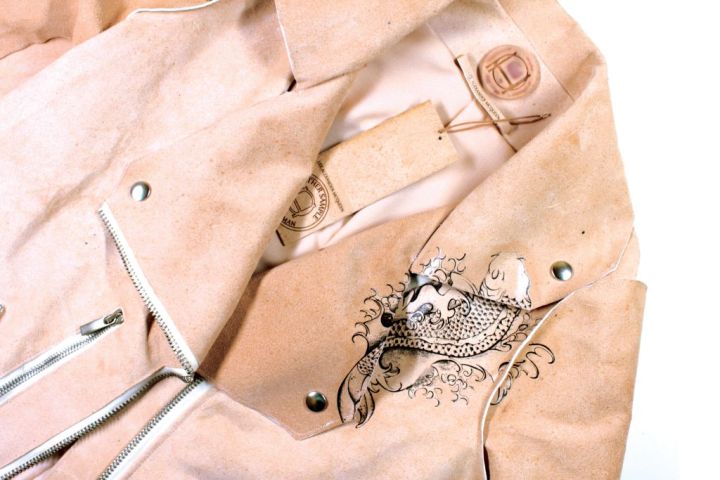
Slovenian-educated Gorjanc is working on her Masters degree in Material Futures at Saint Martins College of Art and Design in London, according to her CV. Saint Martins is McQueen’s alma mater. Examples of a jacket and a backpack from Grojanc’s Pure Human project were made from pigskin. The jacket has a copy of one of McQueen’s tattoos on the left collar and shoulder. The next step for Grojanc is to head to the lab to create materials for the “real” McQueen.
The plan is to grow “skin” from McQueen’s DNA and then tan the skin to use to create leather jackets and bags. Grojanc said the skin will have tattoos the same “locations, size, and design” as McQueen’s. In the lab, the skin will given moles and freckles created by DNA manipulation. The skin, like all undyed leather, also can be sunburned.
“With the tattoos and manipulation of freckles and sunburning, I wanted to showcase the material,” said Gorjanc. “I think that was really important in terms of getting this connection between the jacket and McQueen.”
While Gorjanc did not patent McQueen’s DNA (you can’t do that), she filed a patent application in May for “bioengineered genetic material that is grown in the lab using tissue-engineering technology and the process of de-extinction.” As Quartz explained, “De-extinction allows you to extract genetic material from a deceased source.”
The “source” for Gorjanc’s McQueen eventual collection is hair samples which were put on the labels of a 1992 McQueen collection called “Jack the Ripper Stalks His Victims.” Gorjance said she’s “reasonably sure” the hair is authentic McQueen as she spoke to a model for the 1992 collection who said she was with him when he put the hair on the labels.
Gorjanc isn’t interested in selling the works for people to actually wear. She is more interested in developing the technology, which she says could create “sustainable, lab-grown leather that doesn’t require slaughtering animals.” She sees the eventual works as art that could be displayed in a gallery or museum, or possibly sold to a collector.
Before you plan a startup based on selling items based on celebrity DNA, you should be aware that it could get very dicey in a legal sense. While you can legally use others’ “abandoned tissue,” such as hair, according to Quartz, you cannot patent, acquire, or protect the rights to someone else’s DNA.
If the technology Gorjanc is using goes more mainstream, it’s not unforeseeable that people might want to create vests, jackets, or accessories from their own “leather” based on their DNA. There may come a time that when someone says they’re wearing “Grandpa’s vest,” it’ll mean something very different than it does now.
Updated on 7-20-16 by Bruce Brown: Deleted statement that an Alexander McQueen representative was positive about the project after the design house contacted Digital Trends.



